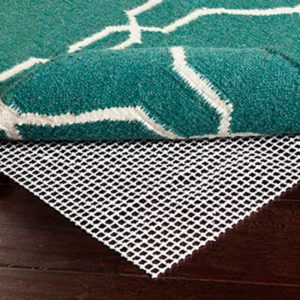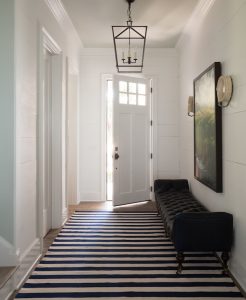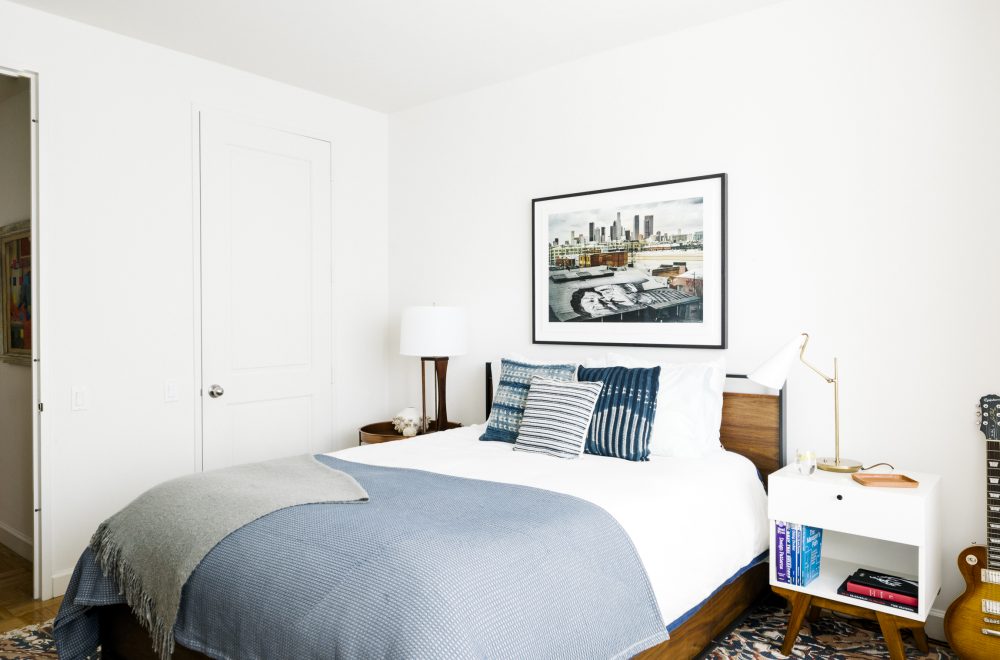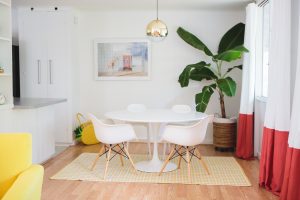Area rugs are essential for tying together the different pieces of furniture in a conversation area. They serve as an anchor for the space and visually separate areas that are used for different purposes. One of the most common questions we get in Design Quickie is “I need a rug to tie it all together.” Let us help you help yourself– read on for our essential area rug tips!
1. I don’t know what size I need!
For a seating arrangement, you want the front two feet (at least!) of every piece of furniture to sit on the rug. If your rug is floating in the middle of the space without touching the sofa or accent chairs, it will look too small. The rug is the anchor of the conversation area, so pick the right size to tie together your furniture pieces.
For a bedroom, the rug should extend at least 18″ from the edges of your bed. On a budget or in a small space, a runner can be used at the foot of the bed to give you the same element of softness.
For a dining room, the size of the table should determine the dimensions of the rug. Ideally, the rug will extend 24″ from all sides of the table. The extra inches of carpet allow for dining chairs to slide comfortably. In a pinch, you can get away with 18″ of extension, but just be aware that chair legs may catch the edge of the rug.
2. But my cat/dog/kid will ruin it!

Everyone deserves a rug, even parents (or parents of fur-babies!). Look for durable, stain resistant materials like polypropylene or polyester, which withstand even the toughest spills but are still affordable and soft. Wool is also naturally odor and stain resistant, which makes it a good candidate for underneath the dining table. Resident DQ expert Elyza has spilled more than one (completely full) glass of red wine on her Crate & Barrel Wool Blend Stripe Dhurrie Rug and no one is the wiser.
3. What the heck is a rug pad?

So you bought a gorgeous and expensive rug — why should you spend a little extra on a rug pad? For unlined rugs, rug pads keep the rug in place. They can also extend the life of your purchase — the pad cushions the rug and protects it from rough flooring materials and everyday wear and tear. Rug pads also give flat woven rugs a little extra softness. For extremely high traffic areas, carpet tape is another good solution (always test adhesive materials in an inconspicuous spot before committing to a larger area to make sure they do not damage your floors!).
4. What texture should I choose?

Flat woven rugs are perfect for underneath dining tables because they won’t show marks from chair legs, and their smooth surface makes it easier to slide chairs in and out. Flat woven rugs also shed less, and are a breeze to clean as there are no raised fibers for food to get stuck in. Keep in mind that flat woven rugs are not plush, so if softness is a priority, opt for a tufted or cut pile rug instead.
Tufted rugs are our go-to for spaces where softness is the priority: they’re great for play rooms, nurseries, living rooms, and bedrooms. “Pile height” refers to how thick the tufted rug is. For example, a shag rug would have a long pile height.
Natural fiber rugs like sisal and jute are tough and rarely show dirt. Many natural fiber rugs blend other materials for added softness (like cotton or chenille), but the texture of the fibers is still rough, so these rugs aren’t the best for rooms where you’ll be spending a lot of time sitting on the floor. Instead, natural fiber rugs make great entryway, mudroom, and living room rugs.


